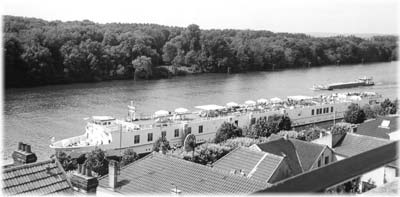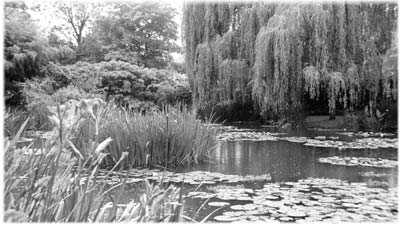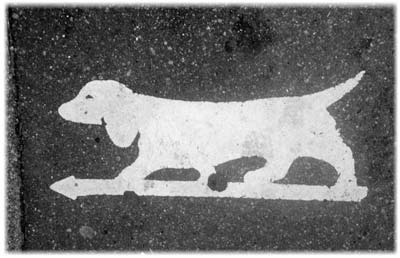Norman landscapes along the Seine
by Deanna Palic, Contributing Editor
While I was contemplating where to go for my 2005 vacation, an invitation to travel as a guest of Peter Deilmann Cruises on their new Seine River program solved my dilemma. Scheduled cruises included sailings from Paris to Rouen, Rouen to Paris and Paris to Paris, all enjoying the same ports of call in varying order: Rouen, Le Havre, Caudebec-en-Caux, Les Andelys, Vernon and Paris. There was also an opportunity to visit Versailles. I chose the June 11th Rouen-Paris sailing.
Normandy
In August 2000 I cruised the Rhône and Saône rivers on the 5-star M/V Cézanne through Provence (March ’01, pg. 32). I was very pleased to learn that this vessel had been transferred to the Seine for the 2005 series of 7-night cruises.
The season operates from March to November and, following the Seine, highlights France’s picturesque Normandy region.
The typical image of Normandy is of a lush, pastoral region of apple orchards, contented cows, cider and pungent cheese. The region also spans the windswept beaches of Cotentin and the wooded banks of the Seine valley.
(For more information on Normandy, visit www.normandie-qualite-tourisme.com.)
Getting there
By the time I started surfing the Internet, low airfares were nonexistent. Quite by chance, I was reading The Los Angeles Times’ Sunday Travel section and noticed an unusual ad. Flight Centre (www.flightcentre.com.au), an Australian-based ticket consolidator, had placed an ad that included the declaration, “Lowest international airfares guaranteed, will beat any verifiable fare.”
I called their toll-free number (877/967-5347) and was informed that I should call them back with the lowest airfare I found and the website address where I found it. I surfed and called them back. Verification was established, Flight Centre offered me a lower fare and I booked on the spot.
The lowest fare I found was with American Airlines, from Los Angeles to Paris via New York. The schedule combinations I found on Internet websites had very tight connection times, with arrival flights and departure flights leaving from different American Airlines terminals at JFK. Flight Centre was able to book me on flights with a 2-hour connection time, which provided a nice comfort zone.
Since this discovery, I have been recommending Flight Centre to those who ask me about lowest-possible airfares. All have been very pleased with their professional service and prices.
Unless you purchase your air tickets as part of the Deilmann cruise package, the 2-hour transfer from Charles de Gaulle Airport to Rouen costs $135 per person. I figured that, after an overnight flight, I would be too grumpy for the hassle of getting into Paris to take the train to Rouen ($51 per person) and then a taxi to the pier, so I booked the transfer.
The meeting place was the Sheraton Hotel lobby, located in Terminal 2F. I walked from Terminal 2A, but there are connection buses operating between terminal buildings.
Offered excursions
Very soon after our embarkation on M/V Cézanne, there was a presentation for the sightseeing excursions available for purchase. Unfortunately, having arrived on the vessel directly from the United States, I was too tired to concentrate and come to any decisions by that evening’s deadline.
Not wanting to be left out completely, however, I chose two excursions: Monet’s House in Giverny ($37) and the excursion from Le Havre to the Alabaster Coast ($60). Both were afternoon excursions, giving me leisurely mornings for the entire cruise. No wonder I came home so relaxed!
Had I not been to Versailles ($72) on a previous visit to France, that excursion would have been a must. Deilmann’s excursion brochure listed it as departing from Le Pecq, but, for whatever reason, we did not stop at Le Pecq and the excursion was offered from Conflans-Ste-Honorine. Obviously, this was the first time that the Cézanne had docked there, as I ran into the reception staff in the local tourist office furiously collecting literature.
Giverny & the Alabaster Coast
Giverny is a small town located four kilometers from Vernon, where we docked. It was here that Claude Monet lived from 1883 to 1926. After large-scale restoration work, the property became that of the Claude Monet Foundation, inaugurated in 1980.
Monet’s paintings hang throughout the house, depicting scenes of the Alabaster Coast and other areas we visited on the cruise. His private collection of Japanese engravings was impressive.
While living here, Monet painted his famous “Water Lilies” series. As you walk through his intricately planned water garden, the inspiration for these paintings is apparent. The entire property houses over 200,000 varieties of plants and flowers.
Once we were docked in La Havre and the morning excursion to Honfleur had departed, I enjoyed a quiet breakfast before setting off to explore on my own.
Downtown Le Havre is a considerable walk from the pier. After strolling around, I visited the Musée Malraux (2 blvd Clémenceau) — $4.75 entrance fee. Its exceptional Impressionist collection demonstrates the attraction that Le Havre held for an entire generation of painters. Claude Monet’s “Les Nymphéas,” as well as works by Paul Gauguin, Camille Pissaro and Pierre-Auguste Renoir, were on display.
The museum, closed on Tuesdays and July 14, is open during the week from 11 a.m. to 6 p.m. and on weekends, 11-7.
From Le Havre, the Alabaster Coast tour traveled first to Fécamp, where we toured the fascinating Gothic-style Palais Bénédictine. Part of the palais houses a private museum with books dating back to the 12th century and religious artworks from the medieval and Renaissance periods. One can also view a very unusual collection of door locks, door handles, keys and knockers.
We also visited the distillery, where Bénédictine liqueur is made from a highly secret combination of 27 herbs, the complete process taking two years. For worldwide exportation, 5,000,000 liters per year are produced. At the end of the tour, we were able to relax in the tasting area with samples of Bénédictine, B&B and the special reserve known as Bénédictine Single Cask.
We continued to Étretat, a seaside resort with a magnificent view of the cliffs that are depicted in several of Monet’s paintings. Here we had some time to explore on our own.
If you enjoy meandering around quaint towns, river cruises are for you. Our vessel always docked in the center of or very close to town.
Rouen
On the evening we arrived in Rouen, we witnessed a spectacular light show in front of the Notre-Dame Cathedral. Every evening during high season (11 p.m. during June and July, 10:30 in August and 10 in September), the cathedral’s gothic façade is transformed into a huge artist’s canvas.
At Rouen’s Old Market Square, a cross marks the spot where Joan of Arc was burned at the stake on May 30, 1431. To commemorate the tragedy, the Musée Jeanne d’Arc (33, Place du Vieux-Marché) has brought together a group of wax models, engravings, books and armor which enable the visitor to trace Joan’s life from Domrémy, her birthplace, to the stake. The museum is open daily
(9:30 a.m.-1 p.m. and 1:30-7), with an entrance fee of $4.95.
Continuing on
The main attraction in Caudebec-en-Caux is the Notre-Dame church, built in the 15th and early 16th centuries. The church houses a most unique painting of the “Last Supper” in which the animal being served appears to be a lamb with the head of the devil. (I have seen another distinct painting in Cusco, Peru, where it was cuy [guinea pig], a local specialty, that was being served.)
From Les Andelys I hiked and climbed to Château Gaíllard, the remains of Richard the Lionheart’s fortress dating back to the end of the 12th century. At that time, Richard was King of England and Duke of Normandy.
The fortress was built to protect Rouen and the dukedom of Normandy against Philippé II Auguste of France. Picturesque on its perch, some 330 feet above the Seine, Château Gaíllard seemed to be impregnable. It was, however, conquered in 1204 after a long siege. This defeat finally delivered Normandy to France.
While I toured the château independently, I would recommend the morning tour offered by Deilmann ($35) for those who have difficulty walking, as a bus is provided to transport passengers most of the way up.
Conflans-Ste-Honorine, long an agricultural village, sits at the confluence of the Seine and Oise rivers and was a natural stopping point for bargemen and their cargos.
I enjoyed strolling along the river promenade where a multitude of barges have been turned into houseboat communities. Following steep winding lanes, I inadvertently arrived at the Musée de la Batellerie (Inland Water Transport Museum), located at Château du Prieuré (3 Place Gévelot). This museum is the only one of national importance dedicated to the history of inland navigation.
With its eight rooms devoted to displays, it traces the story of river and canal transport in all its forms. Visitors will learn all there is to know on the subject of river navigation through displays of 200 models of river and canal boats, pictures, drawings and engravings.
Paris
In spite of making numerous visits to Paris, I have never arrived by boat. Our docking place, Quai de Javel Bas in the 15th district, was southeast of the Eiffel Tower and offered a good view of the tower from the deck of the Cézanne.
It is a bit of a walk, but you can get to a Métro stop from the pier or ask reception to call you a taxi. If you have never visited Paris before, definitely take the optional sightseeing tour ($70).
The weather in Paris was glorious, with sunny skies and a temperature of 800 F — perfect for strolling and nursing an espresso at an outdoor café. Remember, the better the view, the more expensive the beverage.
With two other passengers, I went to lunch at a charming restaurant a few blocks from the opera house. As soon as we saw the queue of office workers waiting outside the entrance to Paul (9 rue des Mathurins; www.paul.fr), we knew we were on to something special. The line was for takeout items, but in the back and on the second floor there were quaint dining rooms.
Prices were quite reasonable. I had a quiche Lorraine, which came with a small salad on the same plate, for $8.
For something truly special, try a meal at a cooking school. One that appealed to me but unfortunately was fully booked was L’Atelier des Chefs (phone 011 33 1 53300582; www.atelierdeschefs.com). For $20, you spend 30 minutes in a modern, glass-enclosed kitchen with up to 21 other students making a one-dish meal under the direction of an instructor. Had I been able to secure a reservation, my instructor would have been an English-speaking chef from The Ritz. Definitely call ahead for reservations before you leave home.
The last leg of the journey, a 45-minute drive in traffic from the Quai de Javel Bas to Charles de Gaulle airport, cost $80 including tip.
Cruise in comfort
The M/V Cézanne, built in 1993, was refurbished in 2003. The deluxe, 50-cabin, 100-passenger vessel showcases original works of art that complement its tasteful décor. A very high level of service is accomplished through a ratio of one crew member for every 2.5 passengers.
It should be noted that there are no elevators on board. However, this is not an issue if a cabin is selected on the Rhône deck, where the restaurant, lounge, hairdresser, boutique and reception desk are located.
In port, the gangway was quite level with the pier, and the tour buses left directly from there. If, however, you plan to walk around on your own in Rouen and Paris, there are stairs to contend with to reach the streets above.
On my sailing, the passenger contingent was American and German, about equally divided, and onboard announcements were in both English and German. The German passengers I met were fluent in English and outgoing. An opportunity to mingle with other nationalities always adds an extra ingredient to the travel experience.
The Cézanne’s spacious cabins contain more than adequate closet and drawer space. Roomy marble bathrooms are an added plus.
Films in English and German along with local programming and CNN were shown daily on cabin TVs.
The electric current on board is 220V. Reception has a limited number of hair dryers and converters available, so it would be wise to bring your own appliances with an adapter for the round-hole European outlets.
The Captain’s Welcome and Farewell events were the only evenings designated as “formal.” Nevertheless, there were no tuxedos, few evening jackets for the men and no cocktail dresses among the ladies. Passengers dressed up a trifle more than the daily “smart casual.”
The dining room, serving exquisitely presented Continental cuisine, can accommodate all passengers at one seating. Menu choices were diverse, tastefully prepared and ample. Even so, the dining room staff was happy to serve second helpings. The daily selections on the vegetarian menu exceeded my expectations.
Each evening, a pianist provided background music before and after dinner in the lounge, where there is a small dance floor. On two other occasions, guest French singers entertained.
The official currency on board is the euro, and cash brings a more favorable exchange rate than travelers’ checks. At the end of the cruise, accounts can be settled with credit cards.
Depending on the season, cabin rates for the one-week cruise range from $1,995 to $2,550, based on double occupancy. For more information or reservations, contact Peter Deilmann Cruises (Alexandria, VA; phone 800/348-8287 or visit www.deilmann-cruises.com).





